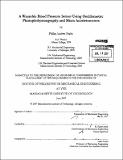| dc.contributor.advisor | H. Harry Asada. | en_US |
| dc.contributor.author | Shaltis, Phillip Andrew | en_US |
| dc.contributor.other | Massachusetts Institute of Technology. Dept. of Mechanical Engineering. | en_US |
| dc.date.accessioned | 2008-02-27T22:13:59Z | |
| dc.date.available | 2008-02-27T22:13:59Z | |
| dc.date.copyright | 2007 | en_US |
| dc.date.issued | 2007 | en_US |
| dc.identifier.uri | http://hdl.handle.net/1721.1/40363 | |
| dc.description | Thesis (Ph. D.)--Massachusetts Institute of Technology, Dept. of Mechanical Engineering, 2007. | en_US |
| dc.description | Includes bibliographical references (leaves 119-124). | en_US |
| dc.description.abstract | Monitoring arterial blood pressure (ABP) with a sensor virtually imperceptible to the wearer, for continuous periods of weeks, months, or years, could prove revolutionary in the diagnosis and treatment of chronic hypertension and heart failure, as well as a monitoring tool for convalescing individuals, and individuals in hazardous duty (such as firefighters or soldiers). To this end, a miniaturizable, non-invasive blood pressure sensor is designed and validated. A solid, coin-sized cuff-less photoplethysmography (PPG) sensor worn over a palpable artery is utilized to measure arterial blood pressure. Measurements are obtained through a modified oscillometric technique which eliminates the need for a high pressure cuff and instead, takes advantage of natural hydrostatic pressure changes caused by raising and lowering the subject's arm. In this work, the principle of hydrostatic oscillometry is first detailed. To better understand the internal mechanisms of pressure propagation within the tissue, a comprehensive non-linear finite element model of the finger base is constructed and validated using a combination of magnetic resonance imaging and experimental tissue stiffness measurements. | en_US |
| dc.description.abstract | (cont.) A prototype finger blood pressure monitor is designed and constructed in combination with a novel accelerometer-based height sensor. The 95% confidence interval for a Bland-Altman comparison between the proposed sensor's mean arterial pressure (MAP) measurements and the simultaneous Finapres MAP measurements is [+919, -283] Pa ([+6.91, -9.04] mmHg). The percent difference between the two methods is shown to be 3.0%. A method for continuous MAP measurements utilizing the sensor system is proposed and is shown to be capable of providing reliable measurements for several minutes. | en_US |
| dc.description.statementofresponsibility | by Phillip Andrew Shaltis. | en_US |
| dc.format.extent | 124 leaves | en_US |
| dc.language.iso | eng | en_US |
| dc.publisher | Massachusetts Institute of Technology | en_US |
| dc.rights | M.I.T. theses are protected by copyright. They may be viewed from this source for any purpose, but reproduction or distribution in any format is prohibited without written permission. See provided URL for inquiries about permission. | en_US |
| dc.rights.uri | http://dspace.mit.edu/handle/1721.1/7582 | |
| dc.subject | Mechanical Engineering. | en_US |
| dc.title | A wearable blood pressure sensor using oscillometric photoplethysmography and micro accelerometers | en_US |
| dc.type | Thesis | en_US |
| dc.description.degree | Ph.D. | en_US |
| dc.contributor.department | Massachusetts Institute of Technology. Department of Mechanical Engineering | |
| dc.identifier.oclc | 188049322 | en_US |
